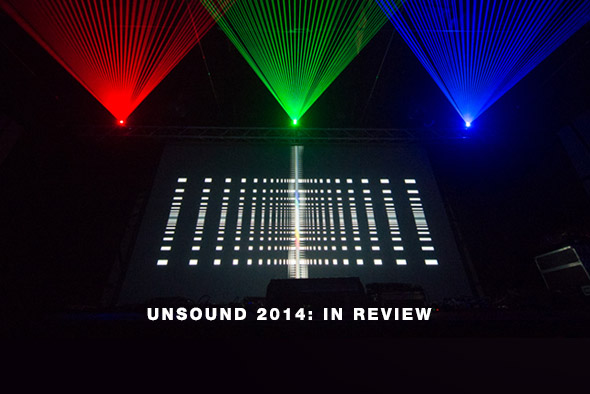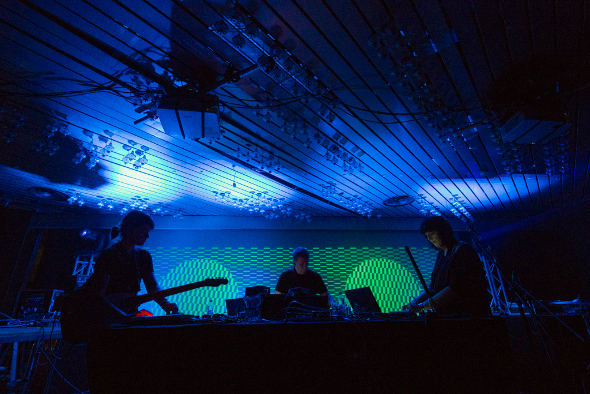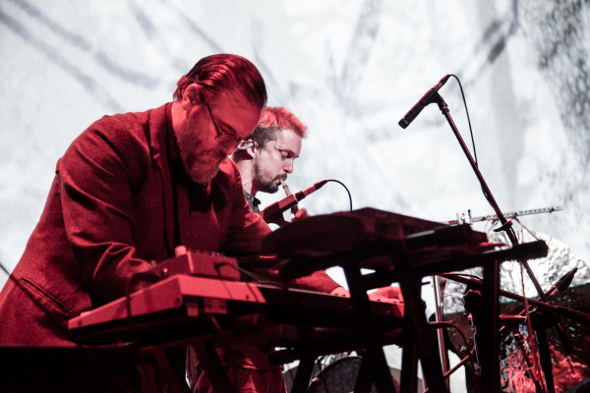Unsound 2014: In review

Scott Wilson and Chloe Frieda report on the events of this year’s Unsound festival in Krakow, with Powell, Grouper, Cyclobe and Karen Gwyer among the many highlights.
As ever, this year’s Krakow leg of the international and increasingly sprawling Unsound festival proved itself way ahead of the curve in terms of programming. It’s unlikely you’ll be able to see a line-up of artists inspired by industrial music, a four-hour Teklife marathon, and a B2B2B between Pinch, Mumdance and Logos on consecutive at any other festival. That’s before you’ve factored in Polish improvisational music in a crypt, an orchestral performance of Craig Leon’s Nommos, Container performing with two drummers to create a wall of sound loud enough to level the nearby castle and countless others. Tickets sold out in hours this year, and it’s probably the festival’s stellar reputation spread by word of mouth that did it.
Unsound 2014 was themed around “the Dream,” which revealed its many layers through the discussions, installations and sets of the festival. Perhaps in the most basic sense, the dream can be explored through the surreal experiences and psychedelic effects that are possible through sound. Beyond this surface layer however, the reality of living in 2014 was brought into focus by the festival’s music, talks and installations. In terms of installations, Mark Fell and Ben Vida explored the depths of physical perception and sense through sound, while talks and discussion panels filled the festival days, ranging from TCF discussing his idea for a decentralized music distribution network based on the Bitcoin model to David Keenan’s presentation on ‘Nightmare Culture in English Industrial Music’.
Once again Unsound felt more like an endurance test than a festival at times, with fatigue and sleep deprivation claiming everyone at some point. Despite this, the mood felt even more ebullient than last year; the night-time performances in the shell of the abandoned Hotel Forum more varied than 2013, with boundary-pushing DJ sets from the Janus and Young Echo collectives especially indicative of the festival’s open-minded approach. The mood was cemented during the brilliant closing party, which felt even busier than last year. Those who made the point of staying to the bitter end of Call Super and Objekt’s sublime DJ set were rewarded with a last dance to Wamdue Project’s “King Of My Castle,” a fitting end to a festival whose audience is open to hearing anything.
The sheer scale of Unsound means that there are inevitable hits and misses. Evian Christ’s live set proved one of the unexpected highlights, turning around technical problems to deliver a visceral experience second only to The Bug. Atom™ and Robin Fox’s Double Vision collaboration, pictured above, proved to be the most memorable visual display, utilising a simple set of red, green and blue lasers that created a colourful mesh inside the Muzeum Inżynierii Miejskiej. Robert Hood’s near-perfect minimalism felt at odds with the gleeful disorder of the Diagonal artists next door, while the Ephemera installation, pairing custom scents with commissioned music from Ben Frost, Tim Hecker and Kode9 was as gimmicky in reality as its concept suggested. The scale made it impossible to give any kind of authoritative assessment on the festival as a whole; as such, fesitval attendees Chloe Frieda and Scott Wilson have picked out some of the moments that stuck in their heads long after the Polish vodka had left their systems.
Karen Gwyer
Karen Gwyer’s Thursday evening festival appearance was a peak-time 12am live set, bringing a stellar performance to the Hotel Forum’s hot and sweaty second room. Since Gwyer emerged on the London scene in 2012, she has had a productive couple of years, releasing music on Kaleidoscope, No Pain in Pop and Opal Tapes. Past performances from Gwyer have sometimes meant intensive slow burners, where subtle textures are explored through compounding loops and noise. Previously working within the realms of dark expansive electronic meditations, her work is often propelled by elements of house and techno.
When Gwyer stepped up to the Unsound stage it was a surprise to see her immediately shift gears from past performances, embracing a more club-ready set. The energy of the room was intoxicating, and it really felt like we were seeing something special. Weaving throughout epic 20-minute loops, Gwyer maintained stamina throughout, morphing analog sounds with creative twists and turns. As drum machine beats shuffled alongside mesmeric synth patterns, a sense of urgency was apparent, making it one of the most inspiring acts of the festival. Chloe Frieda

Vessel, Carter Tutti Void, SOPHIE, Felicita and ‘Nightmare Culture’
For me, the most thought-provoking of the week’s talks – and the one that explored the theme of “The Dream” most explicitly was David Keenan’s presentation on “Nightmare Culture in British Industrial Music”. Keenan put forward the argument that if pop is the music of the daytime, then the early industrial music of bands like Throbbing Gristle, Whitehouse, Nurse With Wound and Coil represented the night, a “dark dreamworld” in which these musicians transgressed boundaries to explore the darker side of the human psyche as a kind of psychological cleansing, acting out fantasies of sex and violence through their music channeled through what he described as “adolescent” energies.
Keenan’s argument probably relied too much on his confrontational delivery to get his points across, but it put British industrial music into a perspective I’d never considered before, one that showed up just how completely divorced from the industrial tradition a lot of contemporary “industrial” music is (especially a lot of current techno). Witnessing Vessel’s live set later that night, in which material from his Punish, Honey album was framed by BDSM visuals, I thought back to the artist’s description of the album as being about “the best kind of sex that we don’t like talking about,” while much has been made of the album’s take on what constitutes “British music”. Witnessing the Young Echo member thrashing over his hardware with a torch in his mouth, with a physical and musical intensity of Vatican Shadow’s live sets put his album firmly into the lineage of British industrial music as seen by Keenan.
The rest of the artists that followed in Room One that night – Carter Tutti Void, Ben Frost, Rrose, Perc and Zamilska – seemed chosen for their place in the industrial legacy, but only Vessel’s performance occupied that “dark dreamworld” described earlier by Keenan. Carter Tutti Void did however deliver a powerful set of intersecting rhythms and textures that beat even the reliable Rrose’s live set for sheer impact, but the test card visuals made it clear it was aesthetically very separate from Carter and Void’s days as part of Throbbing Gristle. While the fractured pop abstractions of SOPHIE and Felicita certainly don’t belong anywhere in the British industrial legacy, and were described as “the BuzzFeed of music” by one person that evening, their sets fit into Keenan’s idea of a “dark dreamworld” more convincingly than anything else I heard that night aside from Vessel. People focus on the saccharine elements of SOPHIE and Felicita’s music, but in light of Keenan’s presentation earlier, the diesembodied fragments of the music took on a more sinister quality, one filled with a malevolent adolescent energy. Scott Wilson
Diagonal
Label showcases can be tricky things to pull off at festivals; no matter how engaging they are the prospect of remaining in one place for several hours when there’s another two rooms to check out is always going to be a temptation. All credit then must go to Diagonal, whose motley crew of Powell, Russell Haswell, Bronze Teeth and Evol offered the most enjoyably chaotic mixture of fractured electronics all week. While I dipped in and out of the sweltering Room 2 where they were playing, there was always a reason to go back; Evol’s brain-liquefying synth blasts and accompanying strobe was probably the most extreme thing I heard all week, the nightmares of The Sun’s famous campaign against acid house made incarnate. Russell Haswell was just as brutal, a jumbled mixture of scrap metal thrown in a blender and left to rip through his unsuspecting audience. Bronze Teeth were a little straighter than the others, but their earthy, wavy, untethered take on hardware techno was just the thing to ease the room into the smaller hours.
However, it was Powell’s debut live set that proved the highlight of the night, if not the entire festival. I was apprehensive about how his successfully his jagged take on techno would be performed live through a sequencer, synth and sampler, but it was revelatory. It was a completely different entity to his recorded material; while the opening vocal “I walk with a zombie,” was lifted from his brilliant Death of Rave track “Rider”, the rest felt like it was being created anew, a pulsing morass of writhing drums and blackened pulses of ear-splitting synth bass that pulled your body in three directions at once. I certainly didn’t expect something so seamless and filled with relentless forward momentum from someone whose music can be fractured, jerky and outright difficult to dance to, but Powell combined the best of his signature sound with the pure forward momentum needed to pull off live electronic sets. Over the course of his performance there was a growing sense everyone in the room had been rooting for Powell to pull it off – and as he stood, arms outstretched at the end of his set Tiesto-like, sweating and exhausted, soaking up his much deserved applause, it was clear he did. Scott Wilson

Cyclobe
A deeply brooding live-set from Cyclobe was undoubtedly one of Unsound’s stand-out performances, which took place in the brand new ICE building, a conference centre with concert hall, shiny exterior and white Star Trek-like bathrooms. Dark electronic ruminations emanated from the centre’s smaller stage, with churning noise-drenched rhythms alongside acoustic tones. It was only their fifth live performance as a band, though you wouldn’t have guessed it. Stephen Thrower and Ossian Brown are perhaps best known for their mutual involvement with Coil; meeting in the early 90s, they later started Cyclobe in 1999. Through their work, a wide variety of instruments are embraced, including use of the tulum, hurdy gurdy, duduk, and clarinet, to name but a few.
The tulum (a Turkish form of bagpipe) complemented the droning hurdy gurdy tones of their performance, while also creating a visceral tension that carried throughout the set. Relying on a thick backbone of drone from which their sound was built, minimal drum beats provided an energy boost for some of the heavier tracks. Combining organic sounds from traditional acoustic instruments with electronics, Cyclobe’s music seemed to enter the headspace of a lonely forest wanderer, or perhaps a hermit on the tipping edge of insanity. Chloe Frieda
Jam City
Having released the first hint of his forthcoming second album for Night Slugs just a few days beforehand, there was a palpable sense of curiosity around Jam City’s debut live set at the festival. For what it’s worth, I really like “Unhappy” – I’d heard it described a little unfairly as “chillwave” in the Toro Y Moi vein by one person, and rather more amusingly as “Night Slugs Blub Constructions” by another, but it’s Jack Latham’s continual evolution as an artist that makes him so compelling. So much of Classical Curves had a bittersweet edge to it anyway, it makes sense for him to go in a pop direction, especially when his signature sound is currently being cribbed by a range of up and coming artists working in the instrumental grime scene.
It’s unlikely the audience was expecting a simplistic laptop rendition of his Classical Curves material, but as Latham took to the stage, set up his laptop and sampler and strapped on a guitar, I began to wonder if I was about to witness post-club music’s own ‘Dylan goes electric’ moment. Taking the time to scatter roses on the stage in front of him while the slogan “Love Is Resistance” was projected behind in red and white behind him, Latham walked a fine line between earnestness and parody. In all honesty I’m still not sure which it was, but I had to admire it. Torn Hawk’s sensitively cultivated machismo is part of what makes him such an enigma, and there was something equally compelling about how Latham presented himself.
Unfortunately, his live show didn’t quite have the technical skill to back it up. Manning laptop, sampler and guitar while trying to sing at the same time was obviously too much for him to take on; there were transitional moments that dragged as he struggled to segue from one song to another. His guitar skills, while not awful, were undeniably rough, and his voice audibly struggled to have much impact. Jam City’s debut live set left disappointed a lot of people – not, it seemed, because of his change in direction, but because it just wasn’t executed that well. Scott Wilson

Grouper
Sunday evening saw events move to the main auditorium of ICE building, a space so new it had only just played host to its opening concert a few days before, and still smelled of fresh sawdust inside. In the immense concert hall, Liz Harris aka Grouper approached the stage, removing her shoes and huddling into a cross-legged position before the audience. Harris has gained wide recognition for her work and a strong following over the years, an artist based in Portland, she has been releasing music since 2005, including work on Kranky, Type, Root Strata and her own label, Yellow Electric.
Harris’ Unsound performance was so personal it felt like you were peering into a living room to watch her play instead of sitting in a 2000 capacity auditorium. Thick distorted guitar strums were accompanied by mesmeric droning loops that created a hazy fuzzed-out ambience throughout the set, soothing the eardrums of the listeners while offering a welcome respite from the intensity of the previous night at Hotel Forum. Throughout Grouper’s work, ethereal vocals quietly morph with dream-like frequencies, adhering to dark electronic reflections that flow throughout. Visuals from Paul Clipson complemented the sounds with hypnotic loops, forging a powerful link to Grouper’s sounds and uniting the senses into an audiovisual experience. Chloe Frieda
Photo credits:
Header image, Carter Tutti Void – Camille Blake
Cyclobe, Grouper – Anna Spysz